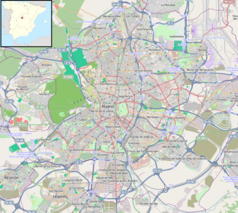Gran Vía
| ||
 Budynek Metrópolis położony na początku ulicy Gran Vía | ||
| Państwo | ||
| Miejscowość | Madryt | |
| 40,4200°N 3,7036°W/40,420000 -3,703610 | ||
Gran Vía – jest jedną z głównych ulic Madrytu. Uznawana za najbardziej reprezentacyjną ulicę miasta, znajduje się w jej okolicy wiele sklepów, kin, teatrów, restauracji i hoteli. Jest popularnym miejscem spotkań, kulturalnym i turystycznym centrum stolicy.
Historia
W XIX w. postanowiono połączyć jedną z głównych ulic – Calle de Alcalá z Plaza de España, planowano stworzyć arterię pomiędzy dzielnicami Salamanca a Argüelles. Wymagało to wyburzenia wielu budynków i wielkich inwestycji. Ostatecznie plany przebudowy centrum Madrytu zatwierdzono w roku 1904. Prace rozpoczęto od wyburzenia pierwszego kwartału kamienic pod koniec 1906, w latach 1907–1911 wybudowano Edificio Metrópolis, budynek stojący na początku Gran Vía, graniczący z Calle de Alcalá. Pierwszy odcinek zbiegu ulic Montera, Hortaleza i Fuencarral powstał w latach 1910-1917, zabudowa w stylu secesji świadczy o stabilnej sytuacji gospodarczej w tym okresie. Drugi odcinek, do Plaza de Callao, wybudowano na początku lat 20. XX wieku, charakteryzują go liczne kina i duże sklepy, najbardziej znanym budynkiem jest powstały w latach 1926-1930 Edificio Telefónica. Ostatnia część ulicy została zbudowana w latach 1925–1929, jest to przedłużenie Gran Vía dochodzące do Plaza de España, którego zabudowę ukończono dopiero na początku lat 50. XX wieku[1].
Obecnie Gran Vía wraz z otaczającą ją charakterystyczną zabudową jest architektoniczną wizytówką Madrytu.
Przypisy
- ↑ Annie Bennett "Madryt" Przewodnik National Geographic Wydawnictwo G+J RBA, National Geographic Society 2006 s. 98-99 ISBN 978-83-7596-187-4
Media użyte na tej stronie
Autor: NordNordWest, Licencja: CC BY-SA 3.0
Location map of Spain
Equirectangular projection, N/S stretching 130 %. Geographic limits of the map:
- N: 44.4° N
- S: 34.7° N
- W: 9.9° W
- E: 4.8° E
Autor: Pedro A. Gracia Fajardo, escudo de Manual de Imagen Institucional de la Administración General del Estado, Licencja: CC0
Flaga Hiszpanii
Crossroads with a major road ahead.
(c) Luis García, CC BY-SA 3.0
Gran Vía, a downtown avenue in Madrid (Spain), at dusk.
Autor: David Adam Kess, Licencja: CC BY-SA 3.0
A Black and White Photo of the the Gran Vía in Madrid Spain
below text is from the English wikipedia
Gran Vía (literally "Great Way") is an ornate and upscale shopping street located in central Madrid.Now, the street is known as the Spanish Broadway, and is one of the streets with more nightlife in Europe. It is known as the street that never sleeps. It leads from Calle de Alcalá, close to Plaza de Cibeles, to Plaza de España. The lively street is one of the city's most important shopping areas, with a large number of hotels and large movie theaters; it is also noted for the grand architecture prevalent among many of its buildings. Now, most of the theaters are being replaced by shopping malls. It is considered a showcase of early 20th century architecture, with patterns ranging from Vienna Secession style, Plateresque, Neo-Mudéjar, Art Deco and others.
In the mid 19th century, Madrid's urban planners decided that a new thoroughfare had to be created, connecting the Calle de Alcalá with the Plaza de España. The project required many buildings in the center of the city to be demolished, earning it the name of 'an axe blow on the map'. Decades after the first plans were made, construction still hadn't started and the media ridiculed the project, cynically calling it the 'Gran Vía' or 'Great Road'. Finally in 1904 it was approved and construction started a couple of years later. The last part of the street was completed in 1929.









